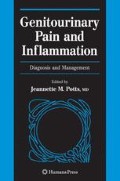Summary
Although often a necessary intervention, urinary catheters are the leading cause of urinary tract infection (UTI) in hospitalized patients and are associated with significant morbidity, mortality, and cost. Avoidance of prolonged or any bladder catherization is recommended if possible. Pro-active care should be used to maintain optimal mechanical and antimicrobial operations. Numerous trials of oral antibiotics and urinary acidifying agents, antimicrobial bladder washes, antimicrobial drainage bag solutions, and topical disinfectants confirm that bacteriuria and UTI can be suppressed temporarily, but resistant flora eventually appear. Closed drainage systems remain the cornerstone for preventing catheter-associated UTI.
Access this chapter
Tax calculation will be finalised at checkout
Purchases are for personal use only
Preview
Unable to display preview. Download preview PDF.
Referencens
Cornia PB, Amory JK, Fraser S, Saint S, Lipsky BA. “Computer-based order entry decreases duration of indwelling urinary catheterization in hospitalized patients,” Am J Med, 2003; 114 (5):404–407.
Gubbins PO, McConnell SA, Penzak SR. “Current management of funguria,” Am J Heal-Sys Pharm, 1999; 56 (19):1929–1936.
Getliffe K. “Managing recurrent urinary catheter blockage: Problems, promises and practicalities,” J WOCN, 2003; 30:146–151.
Lemke JR, Kasprowicz K, Sandford-Worral P. “Intermittent catheterization for patients with a neurogenic bladder: Sterile versus clean,” J Nurs Care Qual, 2005; 20 (4):302–306.
Liedl B. “Catheter-associated urinary tract infections,” Curr Opin Urol, 2001; 11: 75–79.
Saint S. “Clinical and economic consequences of noscomial catheter-related bacteriuria,” Am J Infect Control, 2000; 28 (1): 68–75.
Saint S, Chenoweth CE. “Biofilms and catheter-associated urinary tract infections,” Infect Dis Clin North Am, 2003; 17 (2):411–432.
Saint S, Kaufman SR, Thompson M, Rogers MA, Chenowith CE. “A reminder reduces urinary catheterization in hospitalized patients,” Joint Commision Journal on Quality and Patient Safety, 2005; 31 (8):455–462.
Saint S, Lipsky BA, Door-Goold S. “Indwelling urinary catheters: A one-point restraint?” Ann Intern Med, 2002; 137 (2):125–126.
Saint S, Lipsky BA. “Preventing catheter-related bacteriuria: Should we? can we? how?” Arch Intern Med, 1999; 159 (8):800–808.
Saint S, Savel RH, Matthay MA. “Enhancing the safety of critically ill patients by reducing urinary and central venous catheter-related infections,” Am J Respir Crit Care Med, 2002; 165:1475–1479.
Saint S, Veenstra DL, Sullivan SD, Chenowith C, Fendrick MA. “The potential clinical and economic benefits of silver alloy urinary catheters in preventing urinary tract infection,” Arch Intern Med, 2000; 160 (17):2670–2675.
Saint S, Wiese J, Amory JK, Bernstein ML, Patel UD, Zeemcuk JK. et al. “Are physicians aware of which of their patients have indwelling urinary catheters?” Am J Med, 2000; 109 (6):476–480.
Toughhill E. “Indwelling urinary catheters: Common mechanical and pathogenic problems,” AJN, 2005; 105 (5): 35–37.
Trautner BW, Darouiche RO. “Catheter-associated Infections,” Arch Intern Med, 2004; 164:842–850.
Trautner BW, Darouiche RO. “Role of biofilm in catheter-associated urinary tract infection,” Am J Infect Control, 2004; 32:177–183.
Trautner BW, Hull RA, Darouiche RO. “Prevention of catheter-associated urinary tract infection,” Curr Opin Infect Dis, 2005; 18: 37–41.
Wilde MH. “Urinary tract infection in people with long-term urinary catheters,” J WOCN, 2003; 30:314–323.
Wilde MH. “Understanding urinary catheter problems from the patient’s point of view,” Home Healthcare Nurse, 2002; 20 (7):449–455.
Editor information
Editors and Affiliations
Rights and permissions
Copyright information
© 2008 Humana Press
About this chapter
Cite this chapter
Michota, F. (2008). Indwelling Urinary Catheters. In: Potts, J.M. (eds) Genitourinary Pain And Inflammation. Current Clinical Urology. Humana Press. https://doi.org/10.1007/978-1-60327-126-4_26
Download citation
DOI: https://doi.org/10.1007/978-1-60327-126-4_26
Publisher Name: Humana Press
Print ISBN: 978-1-58829-816-4
Online ISBN: 978-1-60327-126-4
eBook Packages: MedicineMedicine (R0)

